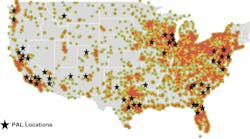As last month's cover story on the changing face of the American truck driver illustrated, Hispanic or, more broadly, Latino Americans now comprise the nation's fastest-growing minority.
The number of Americans who described themselves as Hispanic in the last census numbered 35.3 million (12.5% of the population), making the group almost numerically equal to African Americans, who have long made up the nation's largest minority group.
Despite the fact there have been Hispanic citizens of this country since its inception, most non-Latino Americans still know what is really a highly diverse, highly dispersed community mainly through stereotypical images that inaccurately reflect the reality of so many individual lives.
But getting past the smokescreen of stereotyping which obscures this key demographic group is crucial for fleet managers who must consider recruiting beyond the shrinking white male labor pool to ensure they keep driver's seats filled.
To get beyond those inaccurate images, consider some pertinent analysis of data in the last U.S Census by a leading Hispanic advocacy group, the National Council of La Raza (NCLR).
According to NCLR president Raul Yzaguirre, the group's report “Beyond the Census: Hispanics and an American Agenda” indicates the “growth and youthfulness” of the Hispanic population will play a big role in the nation's social and economic future.
“This analysis shows the future of the nation is tied to the outcomes of its Hispanic communities,” says Yzaguirre. “Now, one in eight Americans is of Hispanic origin, and Latinos are as likely to be found in Milwaukee (now 12% of the city's population) as they are in San Antonio.”
Indeed, the NCLR report indicates that Hispanic population growth occurred not only in “typical” states and cities like California and New York, but also in “non-traditional areas previously not home to significant Latino communities, including Wisconsin, other parts of the Midwest and several states in the South.”
The report notes that while Hispanics are moving to more parts of the country, they still continue to reside mainly in metropolitan areas because “these offer the best employment options” and because “Latinos are especially likely to live in families,” which is more easy to arrange given the housing options offered by cities.
A key theme of the report — and something that should be of keen interest to trucking — is youthfulness. The 2000 Census shows half of all Latinos are under 26 years old and more than one-third are under 18.
Unlike exploitation, opportunity is a two-way street. As Yzaguirre points out, “Latino men are more likely to be in the workforce than any other group of Americans, yet our families make up a large share of the working poor because we continue to be in the lowest-paying jobs and we don't have many opportunities to move up the economic ladder.”
Clearly, taking the effort to make more Hispanics aware of the current and future demand for professional truck drivers would amount to a boost up that ladder for many — and at the same time, it would help truck fleets solve a seemingly intractable personnel shortage.
One trucking group that has already grasped the potential this dynamic holds is the Truckload Carriers Assn. (TCA), which recently formed a partnership with NCLR. The first joint project of the two groups was a driver job fair held last year.
For more information on NCLR and its take on economic mobility, go to www.nclr.org.


